Risk Management Plan: Comprehensive Report on Melbourne Metro Tunnel
VerifiedAdded on 2023/01/19
|27
|4857
|69
Report
AI Summary
This report outlines a comprehensive risk management plan for the Melbourne Metro Tunnel project, aligning with AS/NZS ISO 31000 standards. It details project information, scope, and objectives, followed by an analysis of consultation and communication strategies, both internal and external. The report establishes the project context, including internal and external factors, risk criteria, stakeholders, roles, and responsibilities. The core of the report focuses on the risk assessment process, encompassing risk identification, analysis, and evaluation. It then explores various risk treatment options, culminating in a discussion of risk monitoring and review processes, including risk closure. The report provides a detailed framework for managing risks associated with the metro tunnel construction, ensuring project success.
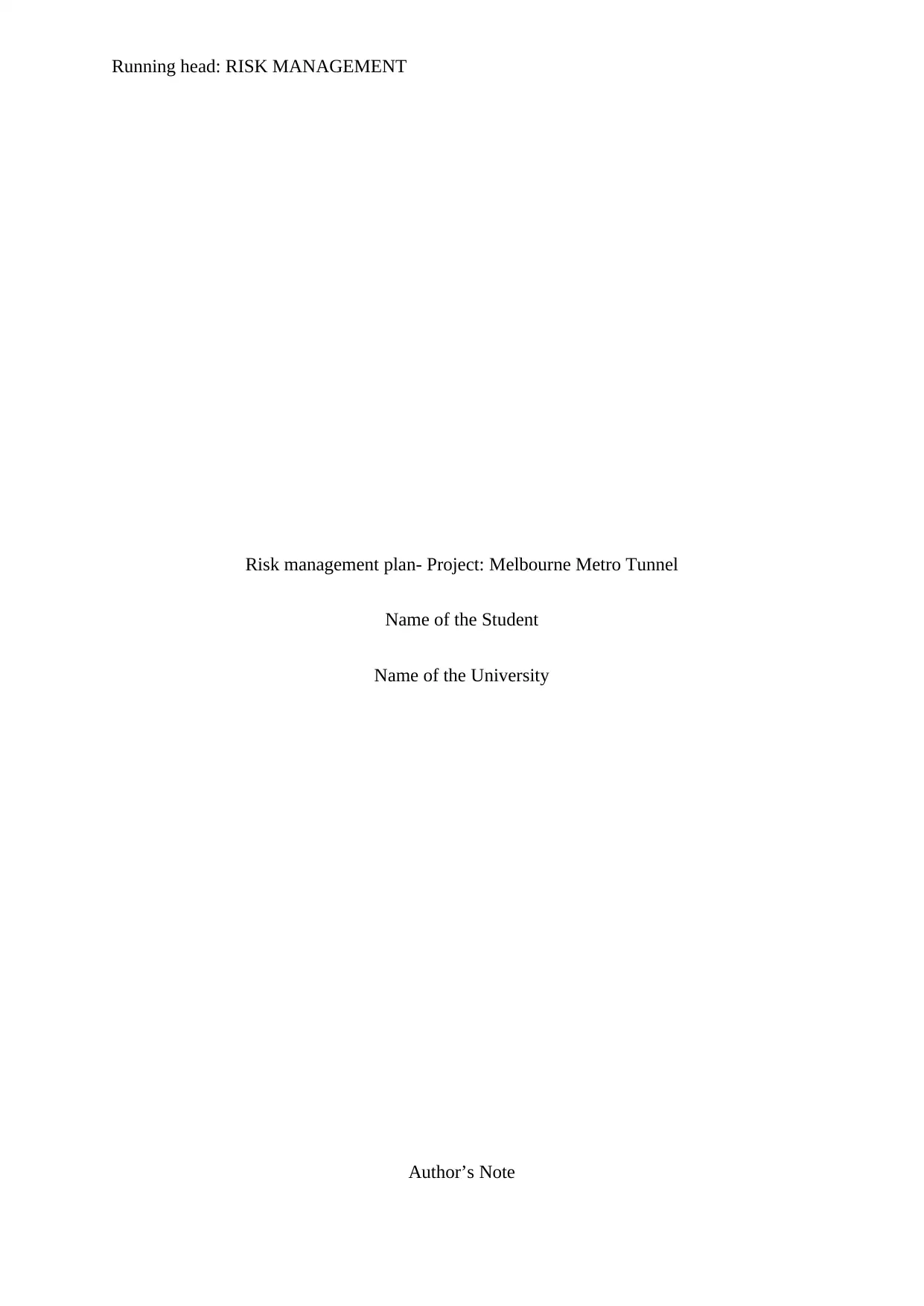
Running head: RISK MANAGEMENT
Risk management plan- Project: Melbourne Metro Tunnel
Name of the Student
Name of the University
Author’s Note
Risk management plan- Project: Melbourne Metro Tunnel
Name of the Student
Name of the University
Author’s Note
Paraphrase This Document
Need a fresh take? Get an instant paraphrase of this document with our AI Paraphraser
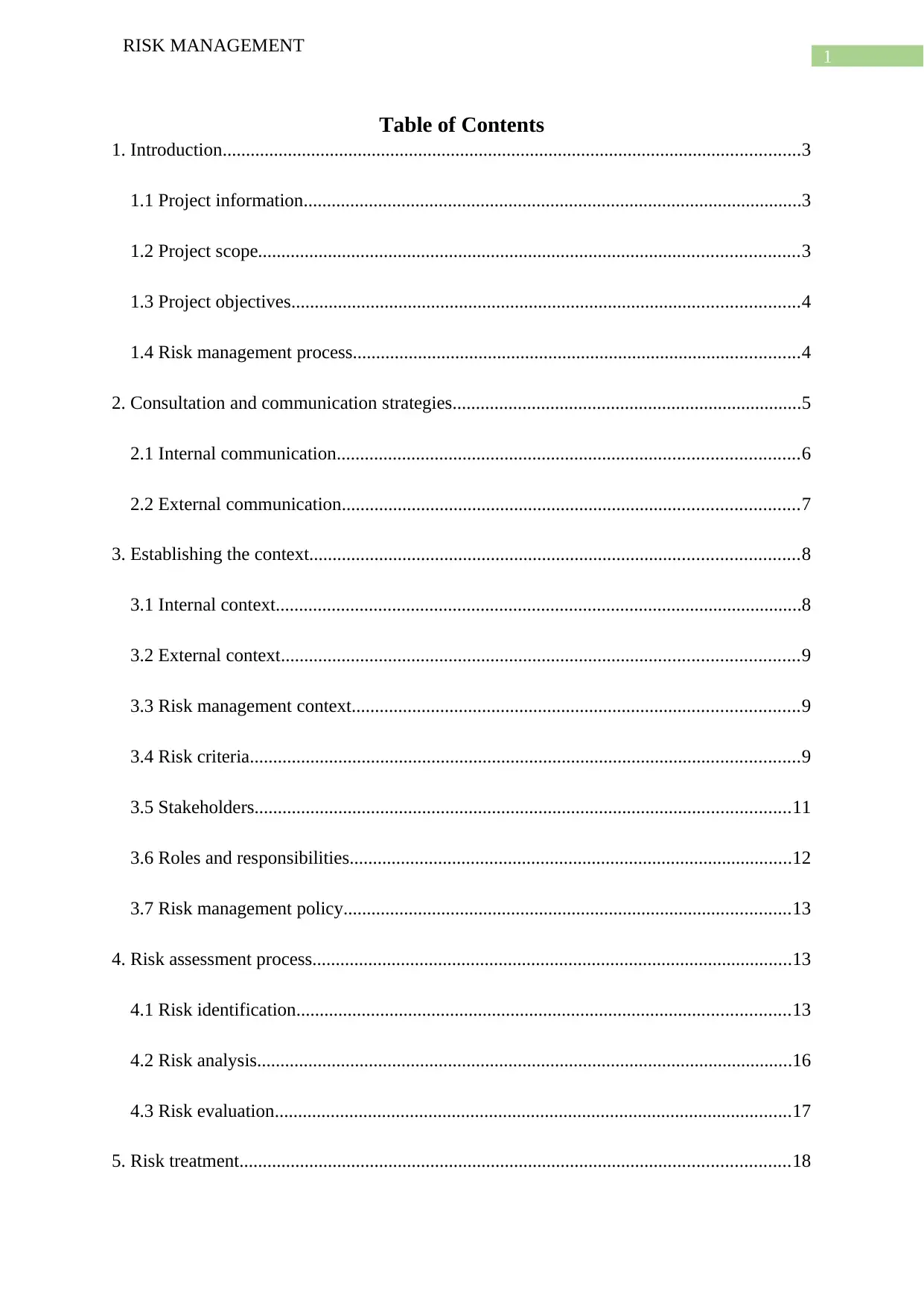
1
RISK MANAGEMENT
Table of Contents
1. Introduction............................................................................................................................3
1.1 Project information...........................................................................................................3
1.2 Project scope....................................................................................................................3
1.3 Project objectives.............................................................................................................4
1.4 Risk management process................................................................................................4
2. Consultation and communication strategies...........................................................................5
2.1 Internal communication...................................................................................................6
2.2 External communication..................................................................................................7
3. Establishing the context.........................................................................................................8
3.1 Internal context.................................................................................................................8
3.2 External context...............................................................................................................9
3.3 Risk management context................................................................................................9
3.4 Risk criteria......................................................................................................................9
3.5 Stakeholders...................................................................................................................11
3.6 Roles and responsibilities...............................................................................................12
3.7 Risk management policy................................................................................................13
4. Risk assessment process.......................................................................................................13
4.1 Risk identification..........................................................................................................13
4.2 Risk analysis...................................................................................................................16
4.3 Risk evaluation...............................................................................................................17
5. Risk treatment......................................................................................................................18
RISK MANAGEMENT
Table of Contents
1. Introduction............................................................................................................................3
1.1 Project information...........................................................................................................3
1.2 Project scope....................................................................................................................3
1.3 Project objectives.............................................................................................................4
1.4 Risk management process................................................................................................4
2. Consultation and communication strategies...........................................................................5
2.1 Internal communication...................................................................................................6
2.2 External communication..................................................................................................7
3. Establishing the context.........................................................................................................8
3.1 Internal context.................................................................................................................8
3.2 External context...............................................................................................................9
3.3 Risk management context................................................................................................9
3.4 Risk criteria......................................................................................................................9
3.5 Stakeholders...................................................................................................................11
3.6 Roles and responsibilities...............................................................................................12
3.7 Risk management policy................................................................................................13
4. Risk assessment process.......................................................................................................13
4.1 Risk identification..........................................................................................................13
4.2 Risk analysis...................................................................................................................16
4.3 Risk evaluation...............................................................................................................17
5. Risk treatment......................................................................................................................18
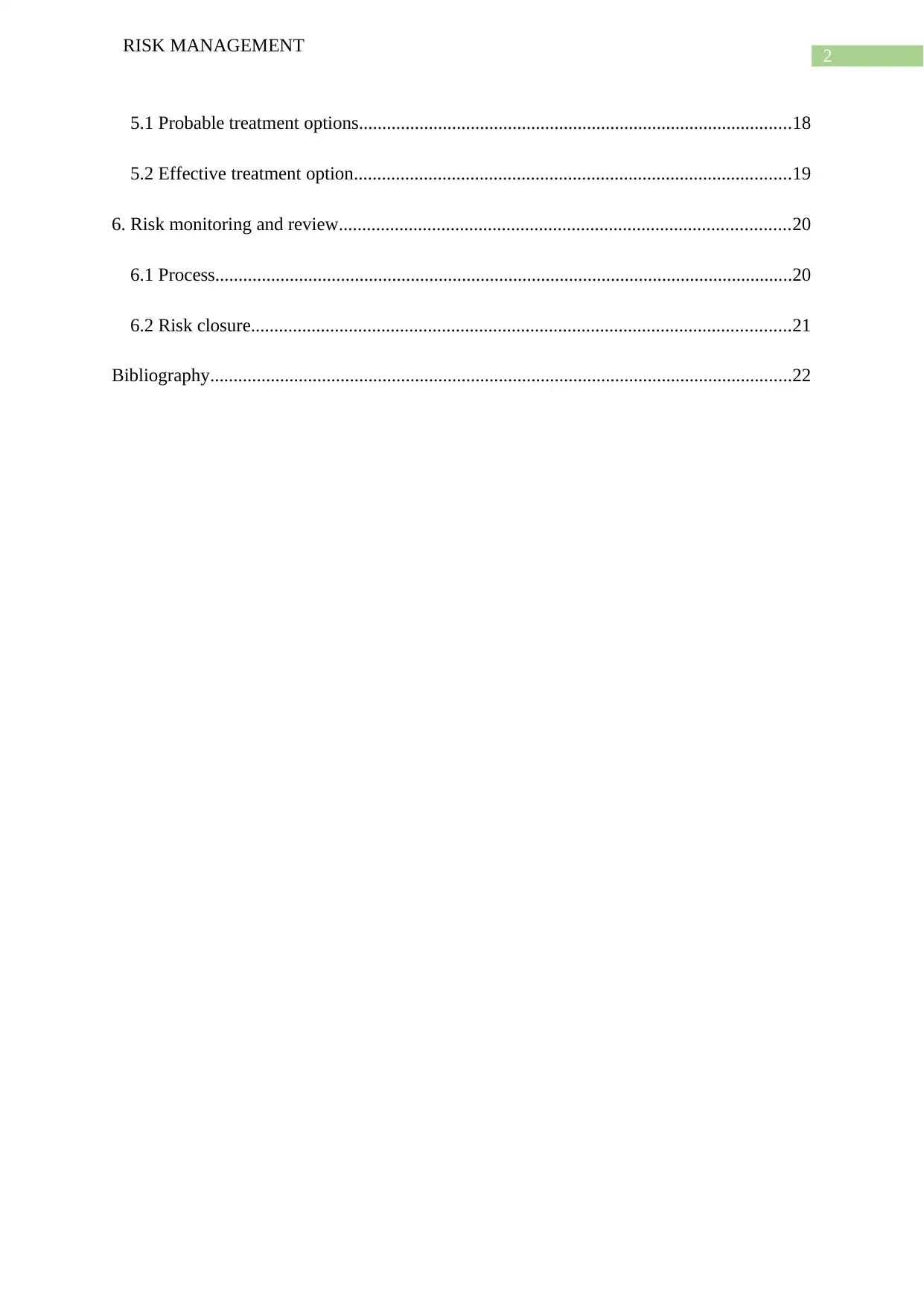
2
RISK MANAGEMENT
5.1 Probable treatment options.............................................................................................18
5.2 Effective treatment option..............................................................................................19
6. Risk monitoring and review.................................................................................................20
6.1 Process............................................................................................................................20
6.2 Risk closure....................................................................................................................21
Bibliography.............................................................................................................................22
RISK MANAGEMENT
5.1 Probable treatment options.............................................................................................18
5.2 Effective treatment option..............................................................................................19
6. Risk monitoring and review.................................................................................................20
6.1 Process............................................................................................................................20
6.2 Risk closure....................................................................................................................21
Bibliography.............................................................................................................................22
⊘ This is a preview!⊘
Do you want full access?
Subscribe today to unlock all pages.

Trusted by 1+ million students worldwide
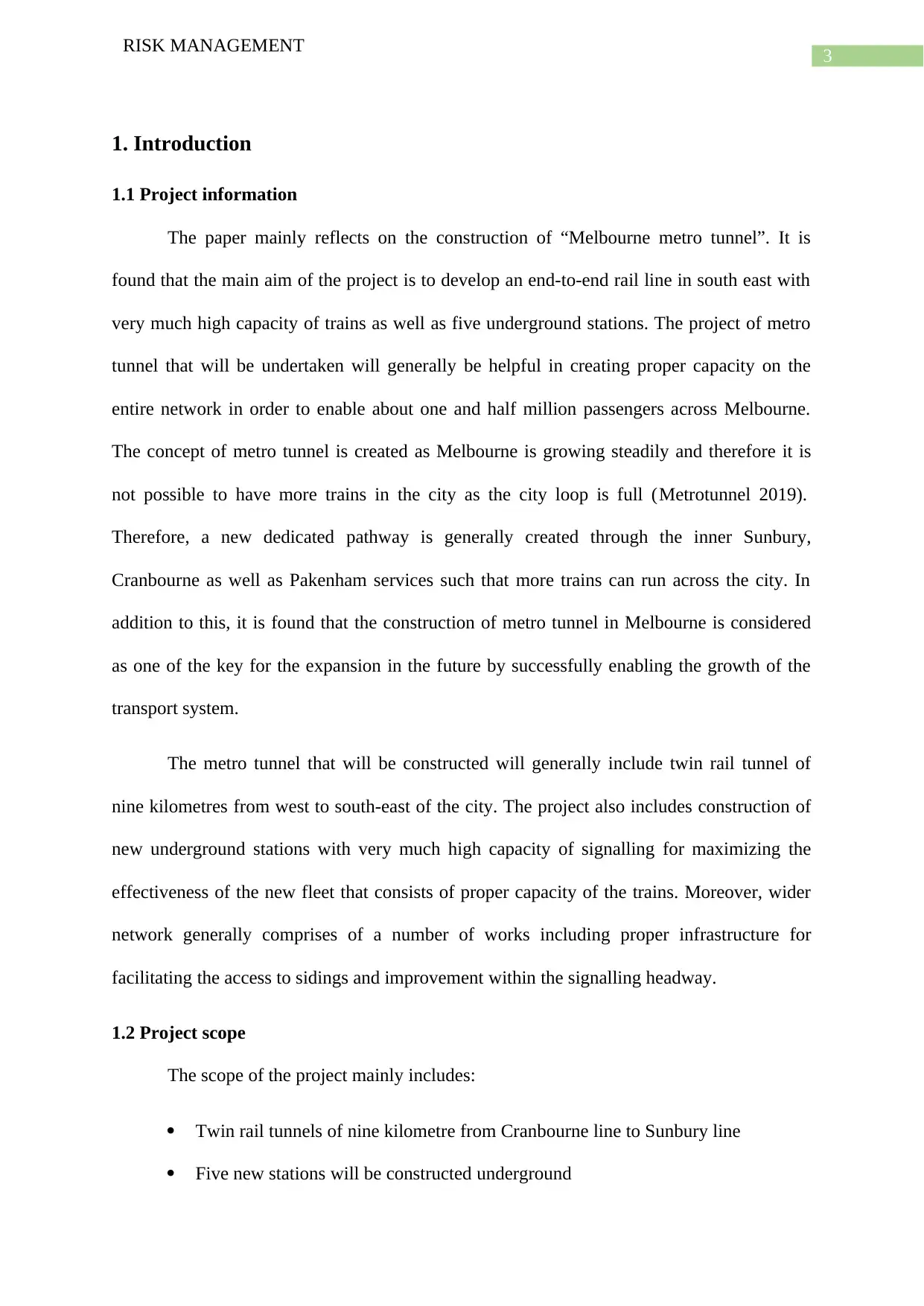
3
RISK MANAGEMENT
1. Introduction
1.1 Project information
The paper mainly reflects on the construction of “Melbourne metro tunnel”. It is
found that the main aim of the project is to develop an end-to-end rail line in south east with
very much high capacity of trains as well as five underground stations. The project of metro
tunnel that will be undertaken will generally be helpful in creating proper capacity on the
entire network in order to enable about one and half million passengers across Melbourne.
The concept of metro tunnel is created as Melbourne is growing steadily and therefore it is
not possible to have more trains in the city as the city loop is full (Metrotunnel 2019).
Therefore, a new dedicated pathway is generally created through the inner Sunbury,
Cranbourne as well as Pakenham services such that more trains can run across the city. In
addition to this, it is found that the construction of metro tunnel in Melbourne is considered
as one of the key for the expansion in the future by successfully enabling the growth of the
transport system.
The metro tunnel that will be constructed will generally include twin rail tunnel of
nine kilometres from west to south-east of the city. The project also includes construction of
new underground stations with very much high capacity of signalling for maximizing the
effectiveness of the new fleet that consists of proper capacity of the trains. Moreover, wider
network generally comprises of a number of works including proper infrastructure for
facilitating the access to sidings and improvement within the signalling headway.
1.2 Project scope
The scope of the project mainly includes:
Twin rail tunnels of nine kilometre from Cranbourne line to Sunbury line
Five new stations will be constructed underground
RISK MANAGEMENT
1. Introduction
1.1 Project information
The paper mainly reflects on the construction of “Melbourne metro tunnel”. It is
found that the main aim of the project is to develop an end-to-end rail line in south east with
very much high capacity of trains as well as five underground stations. The project of metro
tunnel that will be undertaken will generally be helpful in creating proper capacity on the
entire network in order to enable about one and half million passengers across Melbourne.
The concept of metro tunnel is created as Melbourne is growing steadily and therefore it is
not possible to have more trains in the city as the city loop is full (Metrotunnel 2019).
Therefore, a new dedicated pathway is generally created through the inner Sunbury,
Cranbourne as well as Pakenham services such that more trains can run across the city. In
addition to this, it is found that the construction of metro tunnel in Melbourne is considered
as one of the key for the expansion in the future by successfully enabling the growth of the
transport system.
The metro tunnel that will be constructed will generally include twin rail tunnel of
nine kilometres from west to south-east of the city. The project also includes construction of
new underground stations with very much high capacity of signalling for maximizing the
effectiveness of the new fleet that consists of proper capacity of the trains. Moreover, wider
network generally comprises of a number of works including proper infrastructure for
facilitating the access to sidings and improvement within the signalling headway.
1.2 Project scope
The scope of the project mainly includes:
Twin rail tunnels of nine kilometre from Cranbourne line to Sunbury line
Five new stations will be constructed underground
Paraphrase This Document
Need a fresh take? Get an instant paraphrase of this document with our AI Paraphraser

4
RISK MANAGEMENT
High capacity of signalling for maximizing the efficiency of the new fleet
Interchange of trams between the Domain interchange and Anzac station
1.3 Project objectives
The project objective is to construct metro tunnel for the city of Melbourne for
creating a new end-to-end rail line in south east in order to provide a new dedicated pathway
through the inner Sunbury to Cranbourne such that more trains can run across the city
without creating any problem for the trains that runs on the city.
1.4 Risk management process
As the project that is undertaken mainly engages in the construction of a metro tunnel
and it is analyzed that the construction of the project will face high degree of uncertainties.
According to (McNeil, Frey and Embrechts (2015), risk is mainly defined as one of the event
that generally has a probability of either creating a positive or a negative impact on the
project progress. Thus, it is analyzed that the project of Metro tunnel in Melbourne is facing a
number of issues and challenges as the there is no project that does not have uncertainties, If
the risk and challenges of the project are properly managed then it will be helpful in ensuring
the final project success.
In order to properly ensure the effectiveness of project risk management, it is quite
necessary to adopt proper standard method that should be applied and it is necessary to
include AS/NZS ISO 3000:2009 within the risk management plan so that it can provide
proper guidance to the entire risk management procedure. It is found that AS/NZS ISO
3000:2009 assist in making better commitment in order to understand as well as manage the
risks whether positive or negative (Ho et al. 2015). In addition to this, it is mainly utilized in
order to properly harmonize the entire risk management procedures and further helps in
RISK MANAGEMENT
High capacity of signalling for maximizing the efficiency of the new fleet
Interchange of trams between the Domain interchange and Anzac station
1.3 Project objectives
The project objective is to construct metro tunnel for the city of Melbourne for
creating a new end-to-end rail line in south east in order to provide a new dedicated pathway
through the inner Sunbury to Cranbourne such that more trains can run across the city
without creating any problem for the trains that runs on the city.
1.4 Risk management process
As the project that is undertaken mainly engages in the construction of a metro tunnel
and it is analyzed that the construction of the project will face high degree of uncertainties.
According to (McNeil, Frey and Embrechts (2015), risk is mainly defined as one of the event
that generally has a probability of either creating a positive or a negative impact on the
project progress. Thus, it is analyzed that the project of Metro tunnel in Melbourne is facing a
number of issues and challenges as the there is no project that does not have uncertainties, If
the risk and challenges of the project are properly managed then it will be helpful in ensuring
the final project success.
In order to properly ensure the effectiveness of project risk management, it is quite
necessary to adopt proper standard method that should be applied and it is necessary to
include AS/NZS ISO 3000:2009 within the risk management plan so that it can provide
proper guidance to the entire risk management procedure. It is found that AS/NZS ISO
3000:2009 assist in making better commitment in order to understand as well as manage the
risks whether positive or negative (Ho et al. 2015). In addition to this, it is mainly utilized in
order to properly harmonize the entire risk management procedures and further helps in

5
RISK MANAGEMENT
giving a common approach in order to support different types of standards in order to deal
with different risks that is generally not intended for the certification process.
Figure 1: Risk management process in AS/NZS ISO 3000:2009
(Source: Created by Author)
2. Consultation and communication strategies
It is found that in order to undertake the construction of metro tunnel, it is necessary
to prepare a good consultation and communication plan. Both the consultation as well as
communication plays a significant role in giving information about the different types of risks
that are associated with the project and their impact on the success of the project (Bromiley et
al. 2015). Thus, consultation and communication plan are generally categorized into internal
and external which are generally elaborated below:
RISK MANAGEMENT
giving a common approach in order to support different types of standards in order to deal
with different risks that is generally not intended for the certification process.
Figure 1: Risk management process in AS/NZS ISO 3000:2009
(Source: Created by Author)
2. Consultation and communication strategies
It is found that in order to undertake the construction of metro tunnel, it is necessary
to prepare a good consultation and communication plan. Both the consultation as well as
communication plays a significant role in giving information about the different types of risks
that are associated with the project and their impact on the success of the project (Bromiley et
al. 2015). Thus, consultation and communication plan are generally categorized into internal
and external which are generally elaborated below:
⊘ This is a preview!⊘
Do you want full access?
Subscribe today to unlock all pages.

Trusted by 1+ million students worldwide

6
RISK MANAGEMENT
2.1 Internal communication
The internal communication that is required for the project is generally outlined in
the table below by reflecting on the person responsible, frequency of the communication as
well as on the use of proper communication strategy.
Type Frequency Communication
method
Responsible person
Pre-start meeting Daily Pre-starting meeting
is generally
conducted for
reflecting the aim of
the discussion.
Engineers,
construction workers
and site supervisors
Safety committee Monthly Discussion on the
safety procedure
with the help of on-
site meetings.
Safety coordinator,
project manager and
senior managers
Site induction Weekly Induction procedure
will be undertake for
the undertaken
project.
Engineer, safety
coordinator
Safety consultation Weekly The safety
committee generally
discusses the safety
related concerns and
reviews all the work
that are undertaken
Site supervisor,
construction workers
RISK MANAGEMENT
2.1 Internal communication
The internal communication that is required for the project is generally outlined in
the table below by reflecting on the person responsible, frequency of the communication as
well as on the use of proper communication strategy.
Type Frequency Communication
method
Responsible person
Pre-start meeting Daily Pre-starting meeting
is generally
conducted for
reflecting the aim of
the discussion.
Engineers,
construction workers
and site supervisors
Safety committee Monthly Discussion on the
safety procedure
with the help of on-
site meetings.
Safety coordinator,
project manager and
senior managers
Site induction Weekly Induction procedure
will be undertake for
the undertaken
project.
Engineer, safety
coordinator
Safety consultation Weekly The safety
committee generally
discusses the safety
related concerns and
reviews all the work
that are undertaken
Site supervisor,
construction workers
Paraphrase This Document
Need a fresh take? Get an instant paraphrase of this document with our AI Paraphraser

7
RISK MANAGEMENT
by the stakeholders.
2.2 External communication
All the external parties that are generally related with the project must remain linked
with the success which may occur. Thus, communication with this parties are generally done
with the help of personal consultation method or electronic method for making sure that the
stakeholders are not facing any type of challenges. The table that is provided below reflects
on the risks that are associated with external stakeholders.
Type Frequency Communication
method
Responsible person
Incident notification Queerly Information will be
provided to the
external parties of
any type of incidents
that occur with the
help of format
reports or email.
Project manager
Audit report Occurrence of
reports for incidents
Any type of
conformances are
generally informed
and rectified to the
close out procedure
will be completed.
Safety manager,
Project manager,
client and
supervisors.
Public signage Daily It is found that
signage by the
legislation should be
Site personnel,
engineers
RISK MANAGEMENT
by the stakeholders.
2.2 External communication
All the external parties that are generally related with the project must remain linked
with the success which may occur. Thus, communication with this parties are generally done
with the help of personal consultation method or electronic method for making sure that the
stakeholders are not facing any type of challenges. The table that is provided below reflects
on the risks that are associated with external stakeholders.
Type Frequency Communication
method
Responsible person
Incident notification Queerly Information will be
provided to the
external parties of
any type of incidents
that occur with the
help of format
reports or email.
Project manager
Audit report Occurrence of
reports for incidents
Any type of
conformances are
generally informed
and rectified to the
close out procedure
will be completed.
Safety manager,
Project manager,
client and
supervisors.
Public signage Daily It is found that
signage by the
legislation should be
Site personnel,
engineers

8
RISK MANAGEMENT
provided.
3. Establishing the context
It is found that in context to AS/NZS ISO 31000:2009, it is quite significant to
properly define that specific context by successfully outlining the risk criteria, stakeholders,
internal and externa context, roles and responsibilities as well as the proper management
policy for proper management of the project.
3.1 Internal context
The project of Metro tunnel that is mainly undertaken for allowing proper operational
separation of different types of exiting lines that further helps in increasing the capacity of the
rail network to the frequencies of metro style. In addition to this, it is found that the project is
one of the part of the PTV network development plan. It is found that in February 2015, state
government of Melbourne (Metrotunnel 2019). It is found that in the year 2015, the state
government take the initiative of establishing the Melbourne metro rail authority with the
funding of around $40 million in funding for properly overseeing planning of the project and
around $1.5 million for commencing land as well as property acquisition as well as proper
detailed route related investigation. It is found that the most of the project would be built as a
public private partnership were the private sector generally requires funding much of the
estimated $9 billion cost upfront.
3.2 External context
It is found that the Metro tunnel will generally helpful in creating proper end-to-end
rail line from the south east to west line with appropriate capacity of trains and five different
RISK MANAGEMENT
provided.
3. Establishing the context
It is found that in context to AS/NZS ISO 31000:2009, it is quite significant to
properly define that specific context by successfully outlining the risk criteria, stakeholders,
internal and externa context, roles and responsibilities as well as the proper management
policy for proper management of the project.
3.1 Internal context
The project of Metro tunnel that is mainly undertaken for allowing proper operational
separation of different types of exiting lines that further helps in increasing the capacity of the
rail network to the frequencies of metro style. In addition to this, it is found that the project is
one of the part of the PTV network development plan. It is found that in February 2015, state
government of Melbourne (Metrotunnel 2019). It is found that in the year 2015, the state
government take the initiative of establishing the Melbourne metro rail authority with the
funding of around $40 million in funding for properly overseeing planning of the project and
around $1.5 million for commencing land as well as property acquisition as well as proper
detailed route related investigation. It is found that the most of the project would be built as a
public private partnership were the private sector generally requires funding much of the
estimated $9 billion cost upfront.
3.2 External context
It is found that the Metro tunnel will generally helpful in creating proper end-to-end
rail line from the south east to west line with appropriate capacity of trains and five different
⊘ This is a preview!⊘
Do you want full access?
Subscribe today to unlock all pages.

Trusted by 1+ million students worldwide
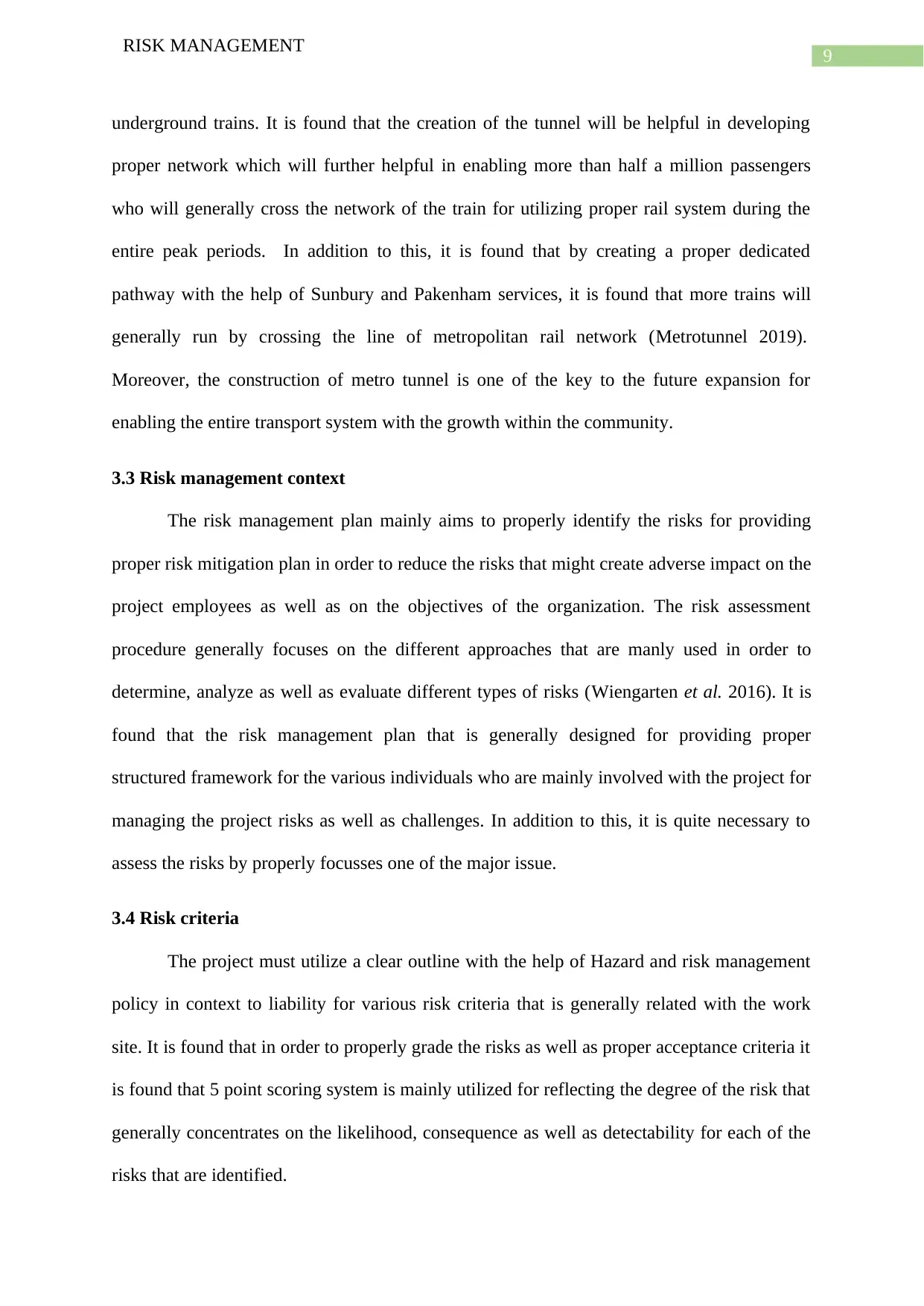
9
RISK MANAGEMENT
underground trains. It is found that the creation of the tunnel will be helpful in developing
proper network which will further helpful in enabling more than half a million passengers
who will generally cross the network of the train for utilizing proper rail system during the
entire peak periods. In addition to this, it is found that by creating a proper dedicated
pathway with the help of Sunbury and Pakenham services, it is found that more trains will
generally run by crossing the line of metropolitan rail network (Metrotunnel 2019).
Moreover, the construction of metro tunnel is one of the key to the future expansion for
enabling the entire transport system with the growth within the community.
3.3 Risk management context
The risk management plan mainly aims to properly identify the risks for providing
proper risk mitigation plan in order to reduce the risks that might create adverse impact on the
project employees as well as on the objectives of the organization. The risk assessment
procedure generally focuses on the different approaches that are manly used in order to
determine, analyze as well as evaluate different types of risks (Wiengarten et al. 2016). It is
found that the risk management plan that is generally designed for providing proper
structured framework for the various individuals who are mainly involved with the project for
managing the project risks as well as challenges. In addition to this, it is quite necessary to
assess the risks by properly focusses one of the major issue.
3.4 Risk criteria
The project must utilize a clear outline with the help of Hazard and risk management
policy in context to liability for various risk criteria that is generally related with the work
site. It is found that in order to properly grade the risks as well as proper acceptance criteria it
is found that 5 point scoring system is mainly utilized for reflecting the degree of the risk that
generally concentrates on the likelihood, consequence as well as detectability for each of the
risks that are identified.
RISK MANAGEMENT
underground trains. It is found that the creation of the tunnel will be helpful in developing
proper network which will further helpful in enabling more than half a million passengers
who will generally cross the network of the train for utilizing proper rail system during the
entire peak periods. In addition to this, it is found that by creating a proper dedicated
pathway with the help of Sunbury and Pakenham services, it is found that more trains will
generally run by crossing the line of metropolitan rail network (Metrotunnel 2019).
Moreover, the construction of metro tunnel is one of the key to the future expansion for
enabling the entire transport system with the growth within the community.
3.3 Risk management context
The risk management plan mainly aims to properly identify the risks for providing
proper risk mitigation plan in order to reduce the risks that might create adverse impact on the
project employees as well as on the objectives of the organization. The risk assessment
procedure generally focuses on the different approaches that are manly used in order to
determine, analyze as well as evaluate different types of risks (Wiengarten et al. 2016). It is
found that the risk management plan that is generally designed for providing proper
structured framework for the various individuals who are mainly involved with the project for
managing the project risks as well as challenges. In addition to this, it is quite necessary to
assess the risks by properly focusses one of the major issue.
3.4 Risk criteria
The project must utilize a clear outline with the help of Hazard and risk management
policy in context to liability for various risk criteria that is generally related with the work
site. It is found that in order to properly grade the risks as well as proper acceptance criteria it
is found that 5 point scoring system is mainly utilized for reflecting the degree of the risk that
generally concentrates on the likelihood, consequence as well as detectability for each of the
risks that are identified.
Paraphrase This Document
Need a fresh take? Get an instant paraphrase of this document with our AI Paraphraser
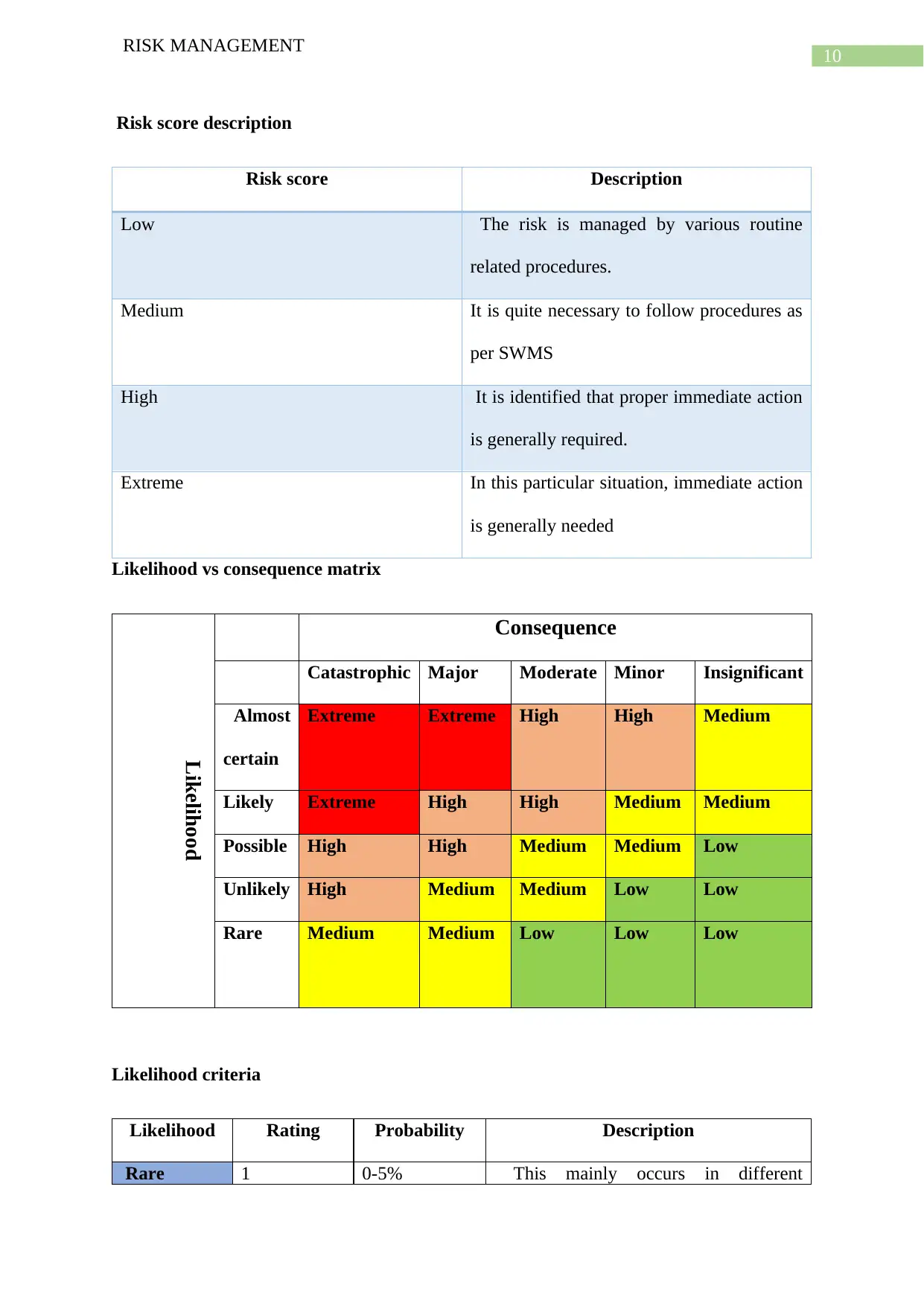
10
RISK MANAGEMENT
Risk score description
Risk score Description
Low The risk is managed by various routine
related procedures.
Medium It is quite necessary to follow procedures as
per SWMS
High It is identified that proper immediate action
is generally required.
Extreme In this particular situation, immediate action
is generally needed
Likelihood vs consequence matrix
Likelihood
Consequence
Catastrophic Major Moderate Minor Insignificant
Almost
certain
Extreme Extreme High High Medium
Likely Extreme High High Medium Medium
Possible High High Medium Medium Low
Unlikely High Medium Medium Low Low
Rare Medium Medium Low Low Low
Likelihood criteria
Likelihood Rating Probability Description
Rare 1 0-5% This mainly occurs in different
RISK MANAGEMENT
Risk score description
Risk score Description
Low The risk is managed by various routine
related procedures.
Medium It is quite necessary to follow procedures as
per SWMS
High It is identified that proper immediate action
is generally required.
Extreme In this particular situation, immediate action
is generally needed
Likelihood vs consequence matrix
Likelihood
Consequence
Catastrophic Major Moderate Minor Insignificant
Almost
certain
Extreme Extreme High High Medium
Likely Extreme High High Medium Medium
Possible High High Medium Medium Low
Unlikely High Medium Medium Low Low
Rare Medium Medium Low Low Low
Likelihood criteria
Likelihood Rating Probability Description
Rare 1 0-5% This mainly occurs in different
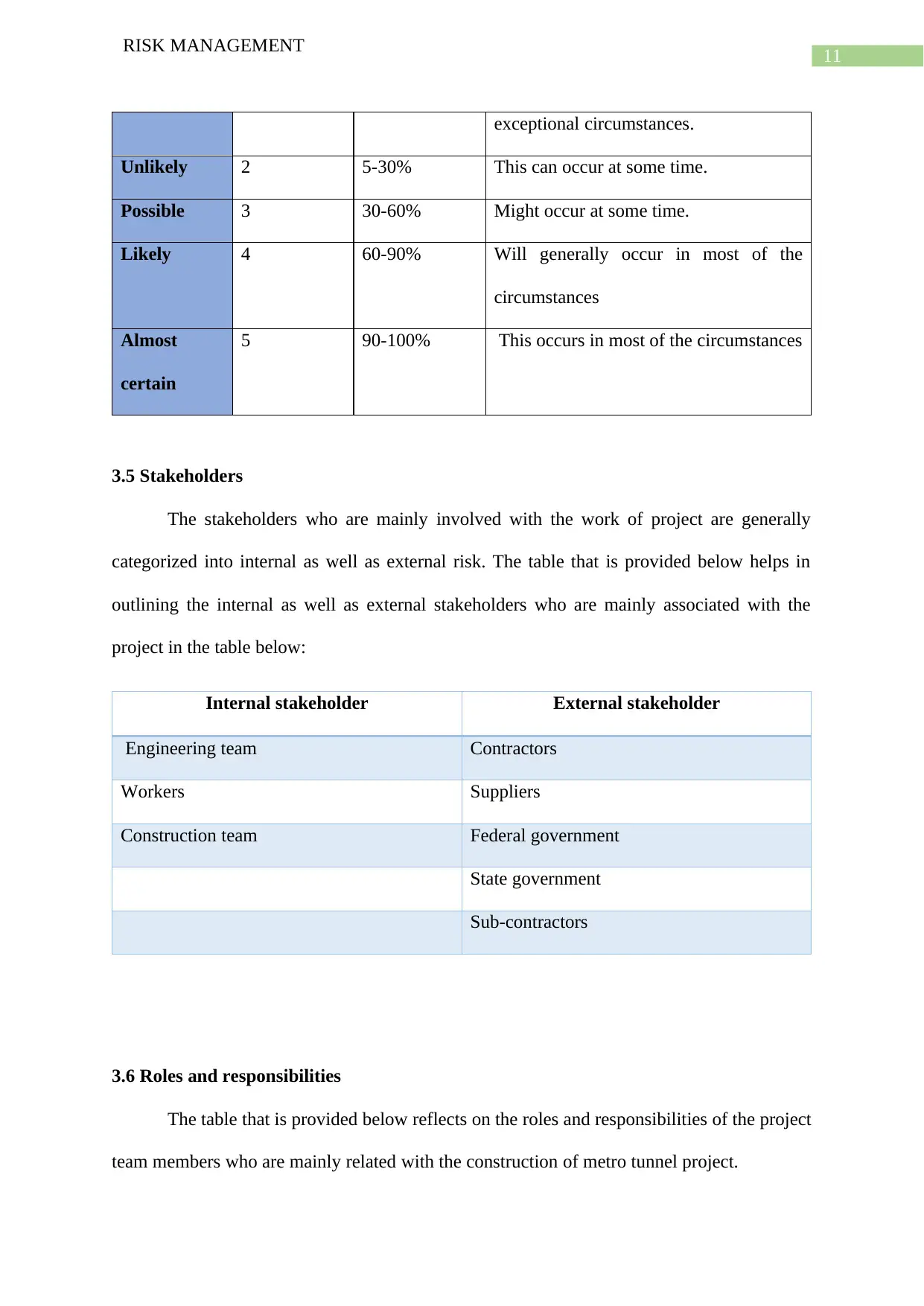
11
RISK MANAGEMENT
exceptional circumstances.
Unlikely 2 5-30% This can occur at some time.
Possible 3 30-60% Might occur at some time.
Likely 4 60-90% Will generally occur in most of the
circumstances
Almost
certain
5 90-100% This occurs in most of the circumstances
3.5 Stakeholders
The stakeholders who are mainly involved with the work of project are generally
categorized into internal as well as external risk. The table that is provided below helps in
outlining the internal as well as external stakeholders who are mainly associated with the
project in the table below:
Internal stakeholder External stakeholder
Engineering team Contractors
Workers Suppliers
Construction team Federal government
State government
Sub-contractors
3.6 Roles and responsibilities
The table that is provided below reflects on the roles and responsibilities of the project
team members who are mainly related with the construction of metro tunnel project.
RISK MANAGEMENT
exceptional circumstances.
Unlikely 2 5-30% This can occur at some time.
Possible 3 30-60% Might occur at some time.
Likely 4 60-90% Will generally occur in most of the
circumstances
Almost
certain
5 90-100% This occurs in most of the circumstances
3.5 Stakeholders
The stakeholders who are mainly involved with the work of project are generally
categorized into internal as well as external risk. The table that is provided below helps in
outlining the internal as well as external stakeholders who are mainly associated with the
project in the table below:
Internal stakeholder External stakeholder
Engineering team Contractors
Workers Suppliers
Construction team Federal government
State government
Sub-contractors
3.6 Roles and responsibilities
The table that is provided below reflects on the roles and responsibilities of the project
team members who are mainly related with the construction of metro tunnel project.
⊘ This is a preview!⊘
Do you want full access?
Subscribe today to unlock all pages.

Trusted by 1+ million students worldwide
1 out of 27
Related Documents
Your All-in-One AI-Powered Toolkit for Academic Success.
+13062052269
info@desklib.com
Available 24*7 on WhatsApp / Email
![[object Object]](/_next/static/media/star-bottom.7253800d.svg)
Unlock your academic potential
Copyright © 2020–2025 A2Z Services. All Rights Reserved. Developed and managed by ZUCOL.




